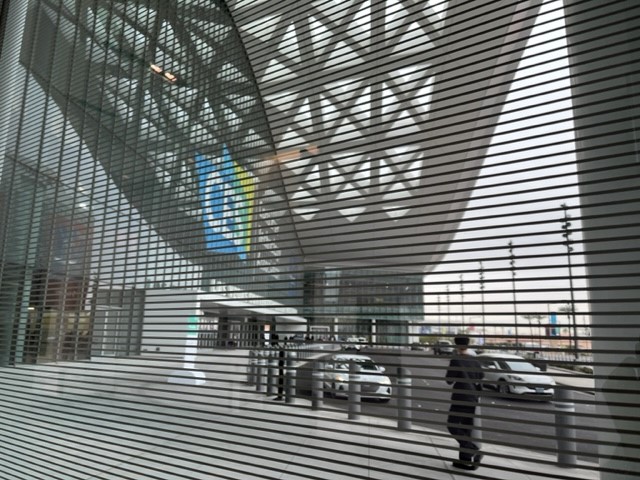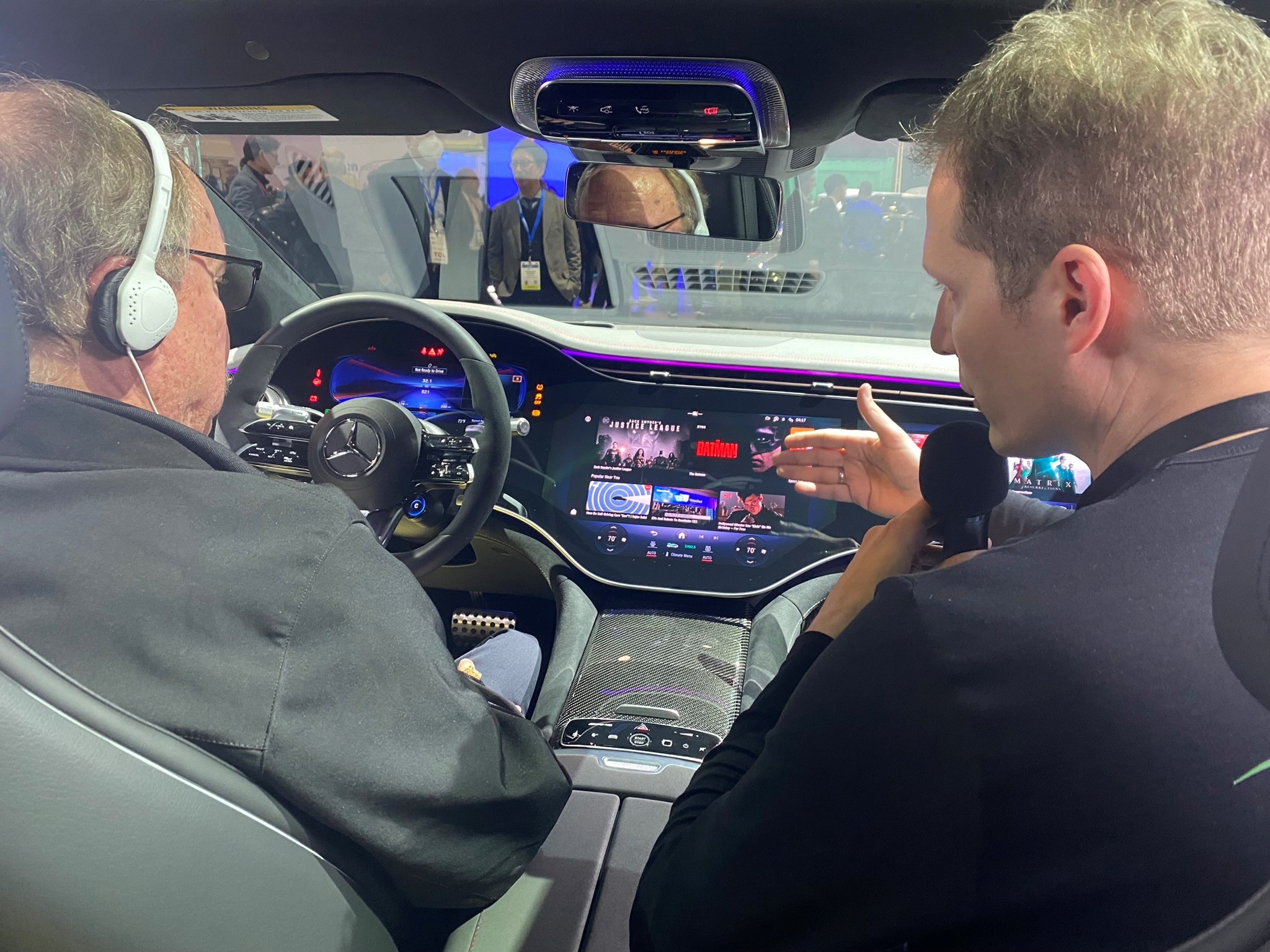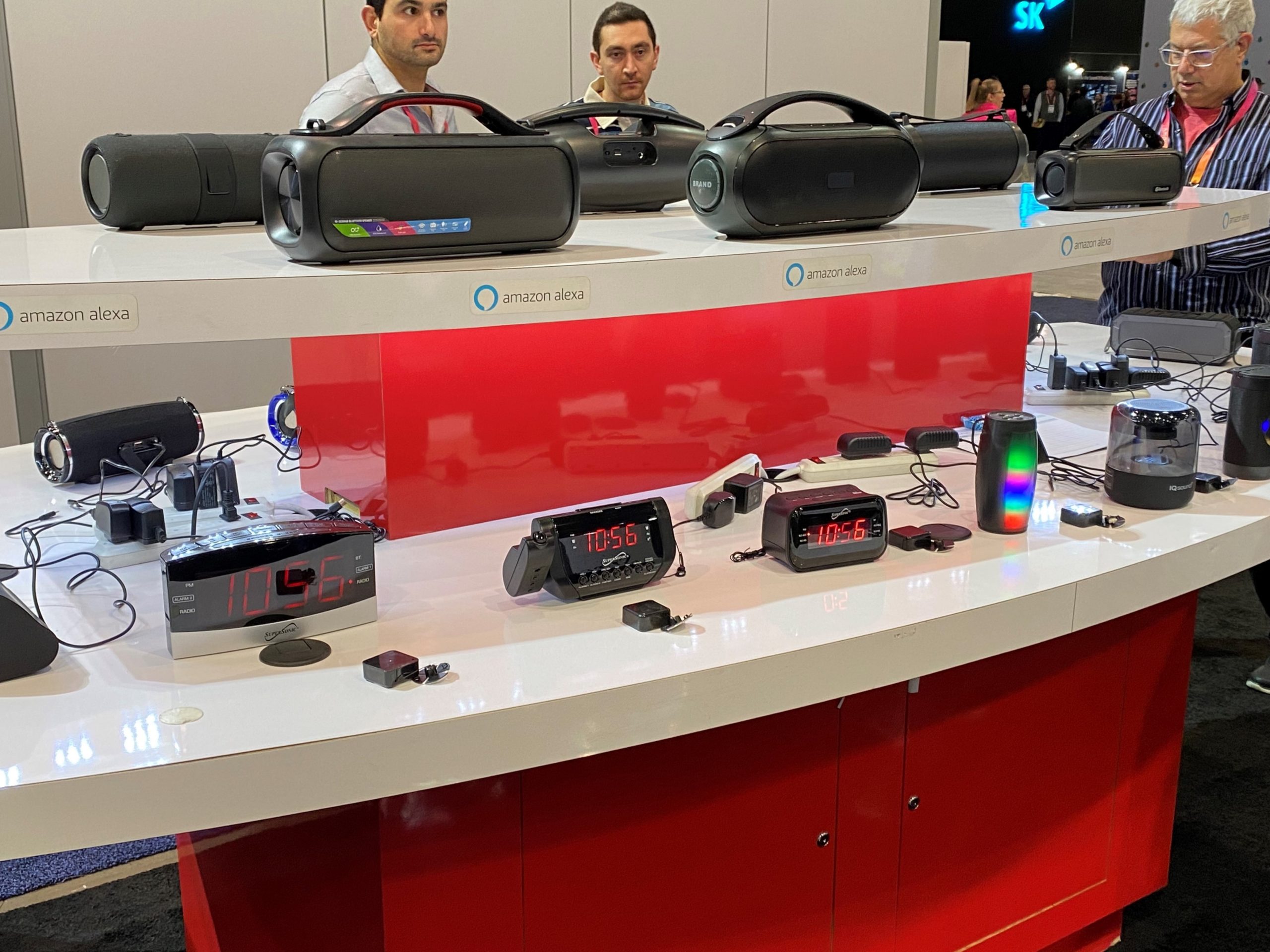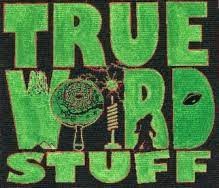
CES 2023 is in the books. It’s hard for me to believe the big event in Vegas took place just four weeks ago. For us at Jacobs Media, we enjoyed “a first” on our tours, now in their fifth year. While we’ve had many “tourists” from the C-suite – CEOs, COOs, CFOs, CTOs) – this year marked our first air talent.
Most of you know Sheri Lynch from “The Bob & Sheri Show,” now for three decades, broadcasting from Charlotte. The show’s “new” flagship is Beasley’s K104.7. Sheri, along with co-host Bob Lacey, wake up thousands of listeners on about 70 affiliate stations all over the U.S.
for three decades, broadcasting from Charlotte. The show’s “new” flagship is Beasley’s K104.7. Sheri, along with co-host Bob Lacey, wake up thousands of listeners on about 70 affiliate stations all over the U.S.
Sheri has another distinction – she wrote what has become JacoBLOG’s most viewed blog post ever – “The Top 5 Radio Topics That Get The Phones Ringing,” originally published in 2017.
There’s not much in the field of entertainment Sheri hasn’t accomplished, winning numerous awards for her show, including Most Influential Women in American radio more times that you can count. She’s an author, an actress, and a podcaster. Her newest podcast is “True Weird Stuff” (and it lives up to its title).
Sheri’s has a great eye and ear for what makes listeners and all of us tick. Her observations from CES provide great perspective from the performer’s point of view. Let’s put it this way – she saw stuff the rest of us didn’t see.
BTW, Sheri took some of the photos that appear in this post. – FJ
“What does CES have to do with radio?”

It’s a question I heard a lot in the weeks leading up to CES 2023. Friends, colleagues, even my family wondered why in the world I was heading to Vegas to be part of something that seemed more about talking toilets, robot bartenders, and this year’s take on a flying car than anything connected to what I do in radio.
And I get it. Every year CES gets a ton of mainstream press, all of which seems to focus on the most experimental and futuristic offerings.

Which makes sense, right? You’re going to get a lot more clicks on a story about an AI-driven interactive sexting app than you are on a modest but critical innovation in lithium ion batteries.
And CES is about the new, about what’s coming just around the next curve. It’s about dreaming the future into reality and so what if some of the wildest things on the CES floor never make it to market?
Those ideas and concepts are meant to inspire – and they do. And radio? We’re over a hundred years old now. Sure, it’d be swell to just rock on the porch and tell war stories and leave all this crazy new technology to the kids to figure out. But the next stop after that is the grave, y’all. It is.
So when I’m asked what in the world CES has to do with radio, my answer is: everything. It’s the Consumer Electronics Show – and wherever the consumer is headed, radio needs to be heading, too.
The thing is, radio cannot take for granted the consumer will take us along for that ride. Literally. The automotive section of CES is thrilling and amazing and terrifying. Why? Because that is the one place where radio has always owned prime real estate. We don’t anymore.
I was part of a group that had to be dragged away from a Mercedes with everything except a king-sized bed, a cold martini, and a radio option on the dash.

I guess it’s possible it did have a radio option somewhere, but everyone clustered around it was too busy being awestruck by the Batman movie playing on the giant screen where a radio used to be, by the eye-tracking technology monitoring driver distraction, by the six and a half foot tall German genius explaining it all, by the sheer, epic, freaking coolness of what is essentially a supercomputer/entertainment hub that happens to be shaped like a car.
Are you thinking, “OK, but that’s a long way off. A lot of that probably won’t ever really happen. And even if it does, it’ll be a tiny fraction of the auto market and people love radio and of course radio will be an option on the dashboard. Like it always has been.”
Except, no. We already know that simply isn’t a given. Not anymore. Manufacturers of electric vehicles have already broken the bad news about the problem of AM radio and electromagnetic interference. Oops. Are you thinking, “OK, but let’s not panic. FM radio doesn’t cause that problem, right?”
No, it doesn’t. But FM has an entirely different challenge that isn’t one bit easier to overcome. It is evolving from being a primary option for information and entertainment in the car to being just one of many options on a beautifully designed digital display. One of many. And FM’s neighbors on that screen will include – already include – the most highly branded, funded, promoted, and popular content platforms on Earth. Just in time for Gen Z to hit the road. Zoomers were born into a world that for them has always been a 24/7 self-curated, on-demand playground. Will they take radio along for the ride?
Are you in a cold sweat yet? Because we haven’t even touched on some of the innovations aimed at children’s entertainment and education. Are you thinking, “Whew, we program to adults 25-54 so who cares about what kids are up to?” I’ve got some tough news: adults 25-54 are not immortal beings sent here to make sure that there is always an audience for Maroon 5 and Journey. They will not live forever. And they are going to be replaced by people who, from toddlerhood, have had the extraordinary power to manipulate media and content to suit their exact preferences and needs in the moment.
 Us telling them how we used to sit next to a boombox cassette recorder just waiting for the radio station to play our favorite song so that we could press ‘record’ sounds an awful lot like your grandpa going on about paying a nickel to see a movie in a theater. In other words, “Blah blah blah.” When you see what’s coming for children – and how companies like Disney are racing to partner with these developers and inventors – well, what you’re seeing is the future. It’s that simple. So how does radio envision and strategize its own future without trying to understand and accommodate and appeal to this next generation of listeners?
Us telling them how we used to sit next to a boombox cassette recorder just waiting for the radio station to play our favorite song so that we could press ‘record’ sounds an awful lot like your grandpa going on about paying a nickel to see a movie in a theater. In other words, “Blah blah blah.” When you see what’s coming for children – and how companies like Disney are racing to partner with these developers and inventors – well, what you’re seeing is the future. It’s that simple. So how does radio envision and strategize its own future without trying to understand and accommodate and appeal to this next generation of listeners?
I was a little bit of a unicorn at CES, because I’m on the talent side of the equation. I’m a content creator. Why was I the only one of my kind to sign up for the Jacobs Media CES tour? I’d love to see more radio content creators at CES. I think it’s a good and important investment for our industry to make. Because if there’s one thing I know for certain about the future of media, it’s this: content is key. Content is everything.
Whether it’s the connected car, a smart speaker, a smartphone, or a wifi-enabled toilet with built-in speakers and snack bar, nothing matters more. Consumers do not care if their favorite song or show comes to them via an over-air broadcast signal or a stream of binary code. They. Don’t. Care. What they want is to tap Play and have the content they want right there. Right NOW.
Radio has been in the content creation and distribution business for over a century. The enormous technological shift we’re wrestling with, however painful, should be one we can navigate. I say “should” because we have to first get out of our own way. What makes radio unique and compelling has never been towers or transmitters or frequency or amplitude. That’s just how we’ve reached listeners. Until now. But none of that is what keeps listeners coming back. It’s what we deliver via those towers and transmitters that matters. The word for that is “content.”
Don’t just wonder what CES has to do with radio – come to Vegas next year and dive in.
Sheri’s brand new podcast, “True Weird Stuff,” is all about everything and anything from Bigfoot to the things that go bump in the night. It’s available where you get your podcasts, including Apple, just a click away.
everything and anything from Bigfoot to the things that go bump in the night. It’s available where you get your podcasts, including Apple, just a click away.
- A 2020 Lesson?It Could All Be Gone In A Flash - April 24, 2025
- How AI Can Give Radio Personalities More…PERSONALITY - April 23, 2025
- Can Radio Afford To Miss The Short Videos Boat? - April 22, 2025




Great thoughts, Sheri & Fred. I had lunch just yesterday with a friend who co-hosted Morning Radio here in Denver for years, and she had many of those same thoughts. Working for BMW now in my Radio afterlife has been a real education. While I’ve witnessed the radio disappear, model by model, from our cars and I’ve heard so many of our clients express little interest in knowing how to access it, the elephant in the room is that we, as an industry, have created this problem by eliminating the “content” that set us apart. Oh, there are still “voices” on the radio, but other than pure talk radio, they increasingly have nothing relevant to say. Combined with killer commercial loads, we continue to shoot ourselves. The trade pubs continue to boast radio’s reach, but it’s so often a choice of last resort, or not a choice at all in the event of random PPM capture. Bob and Sheri and a few other great personalities aside, we’ve let the technology run over us. No level of tech will turn the tide. It takes stuff coming from the speakers that people like to hear, and that they can’t get anywhere else. This certainly isn’t a unique viewpoint, but it’s our only way out of this mess. Quit simply chasing ratings and do the stuff that got us excited to be in this business when we were teens! (This all reminds me I owe Tony Garcia breakfast, I think) 🙂
Phil, thanks for the BMW POV. Radio broadcasters are going to need to work much harder at creating relevant content and nurturing talented personality in order to maintain relevance, community, and attention in cars (and everywhere else). In the “old days,” radio had a captive audience in the car with drivers (and passengers). That ship sailed years ago. And at CES, a visit to West Hall is all lyou need to see. For her part, Sheri and others continue to deliver compelling content. Radio needs several engaged personalities in every market in order to shine…again. P.S. I’ll buy Tony’s dessert.
I could not agree more, Phil. As someone who is also on the outside looking in, I see an industry that when almost replaced by TV —reinvented itself through agile experimentation (throwing stuff at the wall to see what sticks), and maintained or grew as a result, now too buried in research, digital, and PPMs to try new things that might actually compete with Spotify, Pandora, YouTube, etc. Music radio won’t be it, I don’t believe. The excitement of live, local radio might be though. The window is closing, so I hope someone will try some insane ideas that “will never work,” just to see if one of them does… You know, like playing the same song every hour! Can you imagine how that went over as Radio was losing with long form programming and someone tried that?
Good post, thanx. Was there anything at the show about HD radio?
I’m new to HD Radio. Just bought my first car with it. And lucky to be in Chicago where there are some HD stations to listen to.
But please correct me if I’m wrong here, but don’t stations have to pay a nice fee to use the technology?I’m guessing that is a huge obstacle.
When TV went digital I believe that technology was open source. Why isn’t radio the same way?
The word “content” sounds great. I’m sure you’d find listeners who would trade another subscription for advertiser supported programming.
Why isn’t it used more to create the “-2” stations with different programming?
I cannot explain the reasons for the financial structure, but yes, it costs. (But so does a transmitter & a tower.)
As for why stations don’t do more with their HD2s, it’s a chicken/egg thing. Most have not invested in secondary channels, waiting for “sufficient” HD Radio penetration (at least in cars). When will we reach a tipping point where stations will invest in programming to the point where commercials are saleable? No one knows.
Thanks for the great reply!
Such a good read.
Vital for content creators to see what a average consumer has/will have at their fingertips. Kudos to Sheri for being progressive enough to see that.
You maybe recall (I think we even did a Jacoblog about it) that I took my entire air staff once a year and spent a entire morning going through car dash’s at a new car dealership in years gone by. The “shock and awe” when announcers realize the choices consumers have for the audio consumption in the car was remarkable.
As you guys know so well, it ain’t the station down the dial you have to (just) worry about. It’s a stunning amount of consumer choice with very little barriers to entry anymore!
Good stuff Sheri! (And happy bday FJ:)
Dave, I did blog about it. Your staff making a field trip to a car dealership was a brilliant idea. You would have been blown away by the metaverse car dealership Microsoft & Touchcast demoed at CES.
Thanks you for the kind words!
Another great read from Sheri! Radio would probably not be in the position it’s gotten itself into with more insight like hers. The only thing I MIGHT take issue with–and I say “might” because I’m not sure how much of this is my own radio bias–is where she says “What makes radio unique and compelling has never been towers or transmitters.” I think, maybe, at one time there really was a bigger-than-life “awe” over radio and it’s towers and transmitters. A time when even the most casual listener thought a radio transmitter and a studio filled with huge broadcast equipment really was impressive and exciting–in a way that a laptop and wi-fi modem will never be. And I think radio benefited from that sort of built-in belief that radio was simply cool because it was…radio. (I know I got a lot of instant “how cool that you work in radio” comments back in the day that I don’t think a podcaster or spotify programmer receives.) All that said, IF there was such a time, that time is clearly over. And any broadcaster would do well to heed Sheri’s wise words–and never miss CES again! (And a belated Happy Birthday, Fred!)
David, I agree that for decades it was about radios that received a tower & transmitter delivered signal. A lot of people still listen this way, and will continue to – especially those living in rural areas and/or without hi-speed Internet access. Appreciate the comment on Sheri’s post.